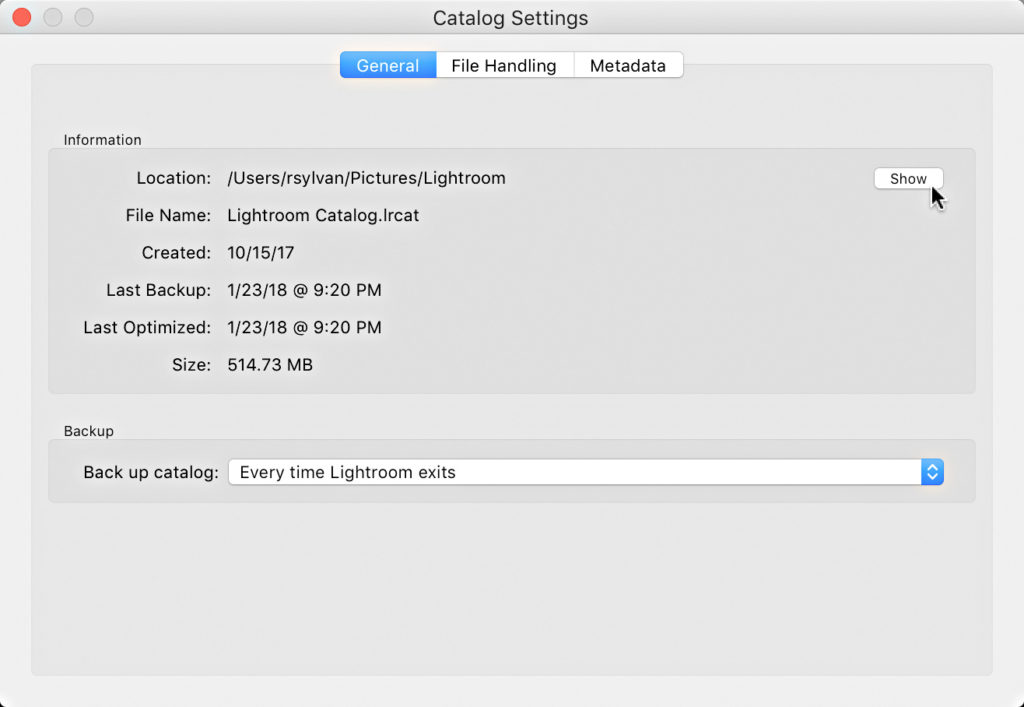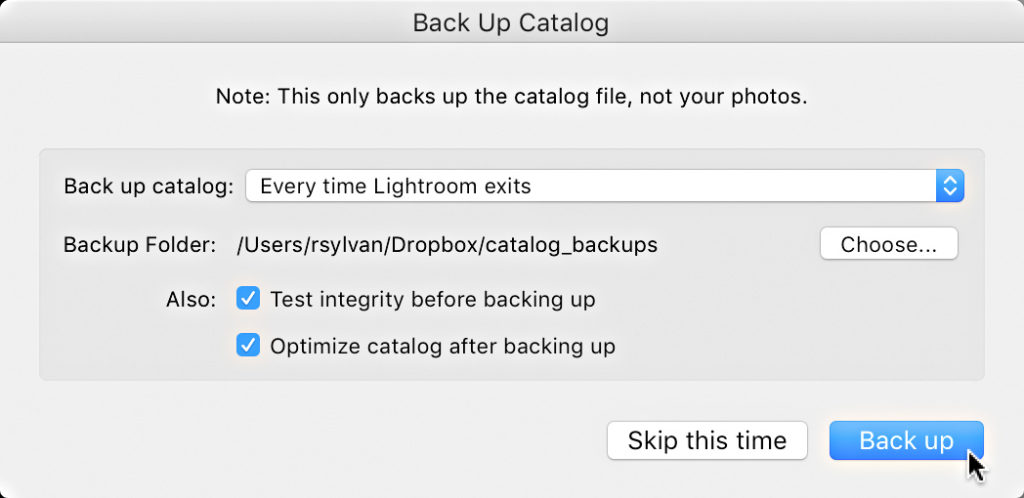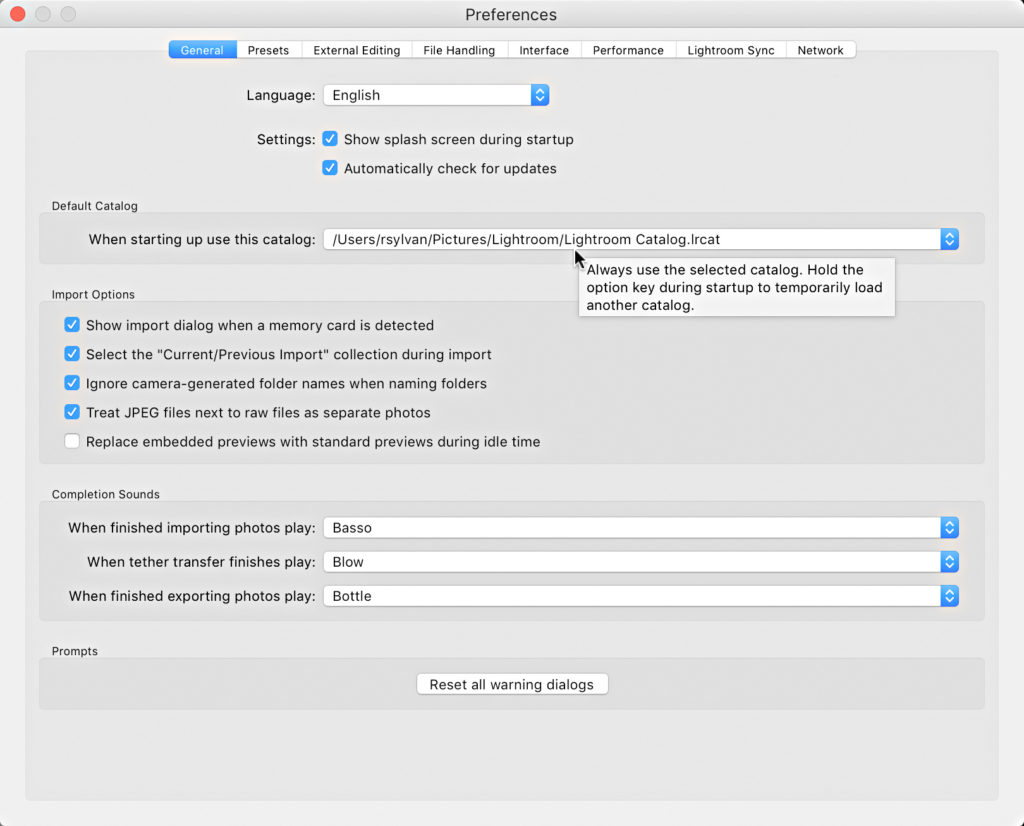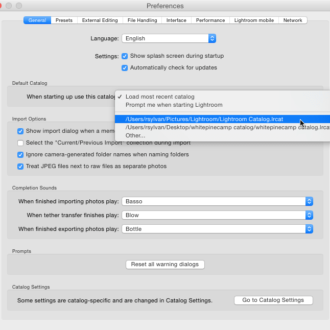Keeping Lightroom Classic’s Files in Check: Part 1
As Lightroom Classic users we focus on the job it does with our photos, both in terms of managing them and processing them, but it is worth taking a moment to think about the footprint the Classic-related files leave on our computers, which when left unchecked only continues to grow over time.
Disclaimer: Let’s just acknowledge that in the grand scheme of things your photos and videos will require far more storage space than your Lightroom catalog and its related files ever will. However, because this is so obvious we all take steps to manage our disk space relating to our photo storage. The files related to running (and backing up) Lightroom tend to accumulate in the background, and it isn’t until we find ourselves running short on disk space that we start to wonder what is going on behind the scenes. My goal is to simply shed a little light on the subject so that you can make the decisions you need for your system. There is not a one-size-fits all answer here, and you shouldn’t just run out and make changes to your setup if you aren’t having any problems. I just want you to be more fully in the driver’s seat as you make decisions down the road.
When you look under Lightroom’s hood you find that there are a number of files that work in concert to make Lightroom function, and all of these require some amount of hard disk space. By default, all of these files exist on your startup drive, and for many of us that drive is already chock-full of lot’s of other files too. Increasingly our startup drives are solid state drives for improved performance, which tend to be smaller in storage capacity. This combination of factors can leave some of us running low on free space, which becomes a performance drag of its own. Let’s take a closer look at what these files are, where they can be found, and what you might be able to do to manage them over time.
The Catalog
As the most important of all of the Lightroom-related files this is a great place to start. By default the catalog is created within a folder named Lightroom within your Pictures folder. If you are not sure where your catalog is located you can go to Lightroom > Catalog Settings > General (PC: Edit > Catalog Settings) and find its name and location displayed along with other important information about the catalog itself. Click the Show button to open a new file browser window with that folder selected.
All of the work you do in Lightroom is automatically stored in that catalog file, and as a result the file size of the catalog grows over time. The size in bytes of that catalog file will depend on how many photos you have imported and how much work you have done on those photos. This catalog, managing about 30,000 images, is about 515 MB, which is not much of a disk space issue. My main catalog on my desktop is over 3GB and manages over 150,000 images.
However, there’s a saying in backpacking that “every ounce counts,” so for some people shaving some megabytes off their catalog might be attractive, but what can you do? The easiest thing to do is to run the File > Optimize Catalog function. Those with really large catalogs are the only ones likely to see any real difference in file size as a result, but those are also the people most likely to be interested in reducing its file size (and possibly improving performance). There is no harm in doing it, so give it a try.
Managing Catalog Backups
While Classic doesn’t have a function to back up your photos it does have an automated mechanism for creating backup copies of the catalog file on a regular basis. If you go back to Catalog Settings > General you can configure Lightroom to periodically create an exact copy of the catalog file on a schedule of your choosing. The next time you exit Lightroom on that schedule you will be prompted to run the catalog backup process, and it is only on that dialog box that you can choose where you want the backup copy created (ideally you’d choose a different drive than the one used for your working catalog). Worth noting that as of Lightroom CC 2015/6 we have the ability to adjust that schedule from the Back Up Catalog dialog box too.
Each time this process runs an exact copy of your catalog (the .lrcat file) at that moment in time is created in the backup location, and then (as of Lightroom CC 2015/6) the backup copy is compressed into a zip file as a way to reduce disk space (and to keep people from opening a backup copy of the catalog by mistake).
Using this backup feature can help protect you against data loss through drive failure (if they are being saved to a different drive) or catalog corruption (which is rare, but can happen and is not always obvious at first), and I highly recommend using it, but even though the backup copies are now compressed, Lightroom will continue to keep creating them until the chosen destination drive is full. Each time the process runs a new (compressed) copy of the catalog is created and there it will remain until the user (you) removes them. This is easy to do, but I’ve encountered many people who have never given it a second thought and have every backup copy of the catalog ever created still sitting in that folder.
I periodically go to the folder where they are created using my file browser and delete all but the most recent few. If you think about it, should you ever need to restore a backup catalog you would choose the most recent one right? But what if the data you were hoping to retrieve wasn’t in the most recent catalog copy, wouldn’t it be nice to have a few iterative versions on hand to go back through? Yes, this is more redundant redundancy, but I personally enjoy the peace of mind of having them around. The really important part is that you need to be in control and not let automated tasks run unchecked. You may just have gigabytes of drive space waiting to be reclaimed.
Important public service announcement, before you go deleting all of your old backup copies make sure you know where your working catalog is located first (this is shown on that Catalog Settings panel we saw earlier) and that it is not somehow located among your backups. You’d be surprised how many people I’ve encountered who only discovered their catalog was among their backups after they deleted it by mistake. How could this happen? The Default Catalog setting found in Preferences > General is usually to blame. By default, it is set to Load most recent catalog, so all it takes is a curious user opening an old backup copy of a catalog, then closing Lightroom to set that old backup copy as the “most recent” and the next time that person launches Lightroom that backup copy opens. Please take a moment to change your Default Catalog preference to anything other than Load most recent!
I’ll wrap this up in next week’s post with a look at Classic’s preview caches. See you then!






In the backup folder, there is an lrcat file, as well as a zip file containing what appears to be the same file. why?
When the Lightroom backup runs it creates a copy of the current catalog and then compresses it into a zip file and stores that zip file in the designated backup location. If you also see an .lrcat file in that location it means that at some point, the backup copy of the catalog was extracted from the zip file and placed in that location.
Great article Rob, so much useful info and a reminder to how the important files work/live/backup
Two questions:
In early versions of Lightroom I occasionally experienced catalog corruption – uncovered only when viewing older images. I remember finding that recent saved versions were also corrupt. Lightroom’s recent versions seem much more stable, so this is perhaps a low risk issue, but would it make sense to keep an older version or two just for safety?
As a Mac user, I rely on Time Machine to handle my catalog back-ups rather than Lightroom. What is your opinion of that approach. For full context, I also back up to Amazon Cloud using Goodsync.
The benefit I see to using Lightroom’s catalog backup over time machine alone is that you can include an integrity check and catalog optimization with the catalog backup process. This might flag a problem sooner. If you only use time machine you may be backing up a problem catalog, and not catch it for awhile. I also use time machine, and it just includes my backup copies too. If I had a problem, I’d just go to my Lightroom backup copy folder to restore.
This couldn’t be more timely for me. I just moved 38K images to a Western Dig RAID array due to an internal hard drive with 50 gigs of space left. I’ve now turned to my Lightroom Folder and what a mess!!! Years of old backup files, and yes my catalogue is in a backup folder form 3 years ago. Ugh!! This sheds some light and I’m starting to delete. Two questions: does the back up function duplicate the “Catalogue previews.lrdata” file too or should I not delete that? Also, can I just move my catalogue out of my old backup folder or should I delete everything and restore from a recent backup? Thanks for this great article.
Glad that was helpful! The catalog backup function only backs up the catalog file (no previews). To move your working catalog out of there:
– close Lightroom
– open your file browser, and navigate to the folder containing your catalog (.lrcat) and its associated previews (.lrdata)
– use your file browser to copy them to a location of your choosing
– once the copy operation is complete, double-click the catalog file to open it into Lightroom (make sure it is the right catalog)
– go to Preferences > General, and set that catalog as the default catalog
– run a catalog backup
– delete the files that you copied out of the backup location
Hi Ron, good info. About 100 years ago I knew how to delete old catalogs but have forgotten. Can you please enlighten me again? Thanks Dale. (if that info is in your dialogue I must have missed while reading)
Hi Dale, You have to do it outside of Lightroom. Just use your file browser, navigate to the files, and delete them like any other files you’d want to delete (just make sure you know where your working catalog is located before you delete and have a good backup in place).
[…] post Keeping Lightroom Classic’s Files in Check: Part 1 appeared first on Lightroom Killer […]
It looks like Lightroom makes a new catalog for me every time I update. For example, I started with Lightroom 5, and only had 1 Lr catalog. When I joined the online lightroom cc 1 1/2 yrs. ago, it made a new catalog. When I updated to Lr Classic, there is a new catalog : Lightroom Catalog-2-2 .
I don’t understand why this is happening, if this is usual?
Thanks for your help. I enjoy your lessons, and that they are short, so I don’t get bogged down with too much information at once.
Hi Lisa,
Yes, with each new version of Lightroom Classic (1, 2, 3, etc.) the first time you open your old catalog in the new version Lightroom creates a copy of that catalog and then updates the copy to work with the new version. Lightroom creates the updated copy in the same folder as the original, so it appends -2 to the end to avoid overwriting the original catalog file. Once you begin using the updated catalog in the new version, you have to manually delete the old catalog file.
You need to:
– determine which catalog is your current working catalog (open Lightroom, go to Catalog Settings > General, and you will see its name and location)
– make sure you have a good back up in place
– delete any old catalog files you no longer need/use
Thanks so much. Does that mean I can delete the lightroom 5 catalog safely as well? I used a friend’s work that had multiple users version. I should have just used a free trial version, but didn’t know there was such a thing at the time. I tried it, liked it, and signed up, but not by converting my trial account into a paid account.
You can delete any catalog you are no longer using. In other words, all you need to keep is your active working catalog, and a few recent backup copies (and then keep those backup copies under control).
Thanks SO much for taking the time to answer me. You have helped de-mystify the whole catalog thing for me.
Rob,
Thanks for easy to understand method to keep things “happy”.
In conjunction with your post a couple of weeks ago about history and snapshots and such….
The size of the catalog can be greatly reduced by going into the develop module, selecting all the photos, and selecting clear history. It will clear all the development steps and reduced my catalog by a factor of two.
The downside, of course, is that you lose the step by step of how you get to the final image, but I find that I just don’t care to keep all that around.
Good point, Eric. Thanks for sharing!
Great reminder. Thanks. Gotta go review my catalog now.
Some helpful reminders there, thank you. I’m usually fairly disciplined about ensuring I have back-up copies of the catalogue on a separate drive, but now I think on it I haven’t done that in quite a while!! A job for this evening I think!
From reading this, I think this has bitten me before. Thanks for the tip about changing from always loading the most recent!